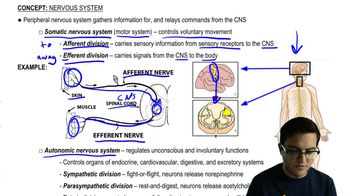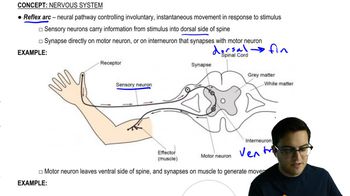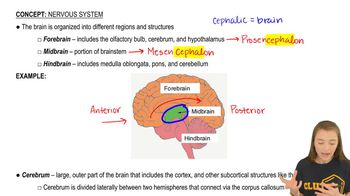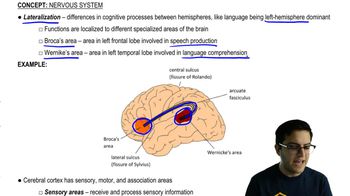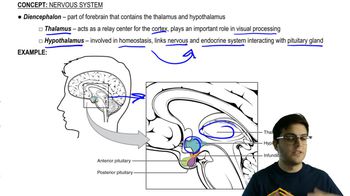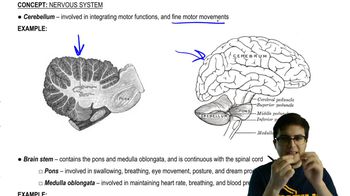Table of contents
- 1. Introduction to Biology2h 42m
- 2. Chemistry3h 40m
- 3. Water1h 26m
- 4. Biomolecules2h 23m
- 5. Cell Components2h 26m
- 6. The Membrane2h 31m
- 7. Energy and Metabolism2h 0m
- 8. Respiration2h 40m
- 9. Photosynthesis2h 49m
- 10. Cell Signaling59m
- 11. Cell Division2h 47m
- 12. Meiosis2h 0m
- 13. Mendelian Genetics4h 44m
- Introduction to Mendel's Experiments7m
- Genotype vs. Phenotype17m
- Punnett Squares13m
- Mendel's Experiments26m
- Mendel's Laws18m
- Monohybrid Crosses19m
- Test Crosses14m
- Dihybrid Crosses20m
- Punnett Square Probability26m
- Incomplete Dominance vs. Codominance20m
- Epistasis7m
- Non-Mendelian Genetics12m
- Pedigrees6m
- Autosomal Inheritance21m
- Sex-Linked Inheritance43m
- X-Inactivation9m
- 14. DNA Synthesis2h 27m
- 15. Gene Expression3h 20m
- 16. Regulation of Expression3h 31m
- Introduction to Regulation of Gene Expression13m
- Prokaryotic Gene Regulation via Operons27m
- The Lac Operon21m
- Glucose's Impact on Lac Operon25m
- The Trp Operon20m
- Review of the Lac Operon & Trp Operon11m
- Introduction to Eukaryotic Gene Regulation9m
- Eukaryotic Chromatin Modifications16m
- Eukaryotic Transcriptional Control22m
- Eukaryotic Post-Transcriptional Regulation28m
- Eukaryotic Post-Translational Regulation13m
- 17. Viruses37m
- 18. Biotechnology2h 58m
- 19. Genomics17m
- 20. Development1h 5m
- 21. Evolution3h 1m
- 22. Evolution of Populations3h 52m
- 23. Speciation1h 37m
- 24. History of Life on Earth2h 6m
- 25. Phylogeny2h 31m
- 26. Prokaryotes4h 59m
- 27. Protists1h 12m
- 28. Plants1h 22m
- 29. Fungi36m
- 30. Overview of Animals34m
- 31. Invertebrates1h 2m
- 32. Vertebrates50m
- 33. Plant Anatomy1h 3m
- 34. Vascular Plant Transport1h 2m
- 35. Soil37m
- 36. Plant Reproduction47m
- 37. Plant Sensation and Response1h 9m
- 38. Animal Form and Function1h 19m
- 39. Digestive System1h 10m
- 40. Circulatory System1h 57m
- 41. Immune System1h 12m
- 42. Osmoregulation and Excretion50m
- 43. Endocrine System1h 4m
- 44. Animal Reproduction1h 2m
- 45. Nervous System1h 55m
- 46. Sensory Systems46m
- 47. Muscle Systems23m
- 48. Ecology3h 11m
- Introduction to Ecology20m
- Biogeography14m
- Earth's Climate Patterns50m
- Introduction to Terrestrial Biomes10m
- Terrestrial Biomes: Near Equator13m
- Terrestrial Biomes: Temperate Regions10m
- Terrestrial Biomes: Northern Regions15m
- Introduction to Aquatic Biomes27m
- Freshwater Aquatic Biomes14m
- Marine Aquatic Biomes13m
- 49. Animal Behavior28m
- 50. Population Ecology3h 41m
- Introduction to Population Ecology28m
- Population Sampling Methods23m
- Life History12m
- Population Demography17m
- Factors Limiting Population Growth14m
- Introduction to Population Growth Models22m
- Linear Population Growth6m
- Exponential Population Growth29m
- Logistic Population Growth32m
- r/K Selection10m
- The Human Population22m
- 51. Community Ecology2h 46m
- Introduction to Community Ecology2m
- Introduction to Community Interactions9m
- Community Interactions: Competition (-/-)38m
- Community Interactions: Exploitation (+/-)23m
- Community Interactions: Mutualism (+/+) & Commensalism (+/0)9m
- Community Structure35m
- Community Dynamics26m
- Geographic Impact on Communities21m
- 52. Ecosystems2h 36m
- 53. Conservation Biology24m
45. Nervous System
Central and Peripheral Nervous System
Problem 6`
Textbook Question
Injury localized to the hypothalamus would most likely disrupt
a. Regulation of body temperature
b. Short-term memory
c. Executive functions, such as decision making
d. Sorting of sensory information
 Verified step by step guidance
Verified step by step guidance1
Identify the primary functions of the hypothalamus in the brain. The hypothalamus is responsible for regulating various autonomic processes, including body temperature, hunger, thirst, and circadian rhythms.
Consider the role of the hypothalamus in regulating body temperature. It acts as the body's thermostat, maintaining homeostasis by triggering responses to either increase or decrease body temperature as needed.
Evaluate the other options provided in the problem: short-term memory, executive functions, and sorting of sensory information. These functions are primarily associated with other parts of the brain.
Short-term memory is mainly associated with the hippocampus, executive functions with the prefrontal cortex, and sorting of sensory information with the thalamus.
Conclude that an injury to the hypothalamus would most likely disrupt the regulation of body temperature, as this is one of its key functions.
 Verified video answer for a similar problem:
Verified video answer for a similar problem:This video solution was recommended by our tutors as helpful for the problem above
Video duration:
2mPlay a video:
Was this helpful?
Key Concepts
Here are the essential concepts you must grasp in order to answer the question correctly.
Hypothalamus Function
The hypothalamus is a small but crucial part of the brain that plays a key role in maintaining homeostasis. It regulates various autonomic processes, including body temperature, hunger, thirst, and circadian rhythms. Damage to the hypothalamus can disrupt these functions, leading to issues such as temperature regulation problems.
Recommended video:
Guided course

Functional Groups
Body Temperature Regulation
Body temperature regulation is a critical function of the hypothalamus, which acts as the body's thermostat. It receives input about the body's current temperature and initiates responses to either conserve or dissipate heat, ensuring the body maintains a stable internal environment. Disruption in this area can lead to conditions like hyperthermia or hypothermia.
Recommended video:
Guided course

Temperature in Aquatic Biomes
Brain Regions and Their Functions
Different brain regions are responsible for specific functions. The hypothalamus is involved in autonomic and endocrine functions, while the hippocampus is crucial for memory, and the prefrontal cortex is associated with executive functions like decision-making. Understanding these distinctions helps in identifying the effects of localized brain injuries.
Recommended video:
Guided course

Terrestrial Biomes: Northern Regions Example 1

 6:53m
6:53mWatch next
Master Organization of the Nervous System with a bite sized video explanation from Jason
Start learningRelated Videos
Related Practice



